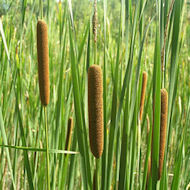
INVASIVE ALERT | BE ON THE LOOKOUT FOR NARROW-LEAF CATTAIL
Being the state with over 11,000 lakes leaves many chances for cattails to thrive, which is true even for Narrow-leaf Cattail that has made Michigan home since 1837. This invasive is now long-established and probably originated in Europe or along the Eastern seaboard, from which it moved westward along the railroads and highway ditches.

Photo courtesy of the University of Michigan
These cattails have leaves about ½ inch wide and roughly half the width of the native broadleaf cattail. There also happens to be a gap of one to three inches between the male and female flowering parts. These two species are capable of reproducing or hybridizing and produce a cross breed called Typha X Glauca, which can exhibit characteristics of both species, but is often taller and more aggressive than either of the parents.
Narrow-leaf cattail, like most other invasive species on the Top 20 list for the Grand Traverse Region, forms dense monocultures that crowd out and replace native plants in high quality natural areas. This in turn can drastically reduce critical food resources for birds, butterflies, and many other wild creatures. According to the Northwest Michigan Invasive Species Network, recent genetic sampling of cattail indicated that the National Lakeshores at Sleeping Bear Dunes and Pictured Rocks are the only national parks in the Midwest with healthy native cattail
populations.
Managing narrow-leaf cattail is not impossible, but full eradication is impractical. Where water level manipulation is possible, cutting or burning the stems just before they flower, prevents oxygen to the roots and then flooding at least 1 meter (3ft). Adding higher water levels encourages muskrats who use the cattails and helps in destroying the monoculture. Foliar herbicide is also effective, particularly when followed with the cutting and flooding, but remember permits are generally required for use in water bodies and wetlands.
For more information see MDEQs Aquatic Nuisance Control website at www.michigan.gov/deqinlandlakes.
Managing and protecting our shores is critical, whether it be the Great Lakes or one of Michigan’s many inland lakes. For boaters, anglers, water enthusiasts, and alike we all know the importance of keeping these waterways clean for species and their habitat. As spring arrives remember to keep on the lookout for narrow-leaf cattail as it begins to reproduce.
This article is part of the ongoing series on invasive species funded in part with funds from the Michigan Invasive Species Grant Program through the Departments of Natural Resources, Environmental Quality, and Agriculture and Rural Development
